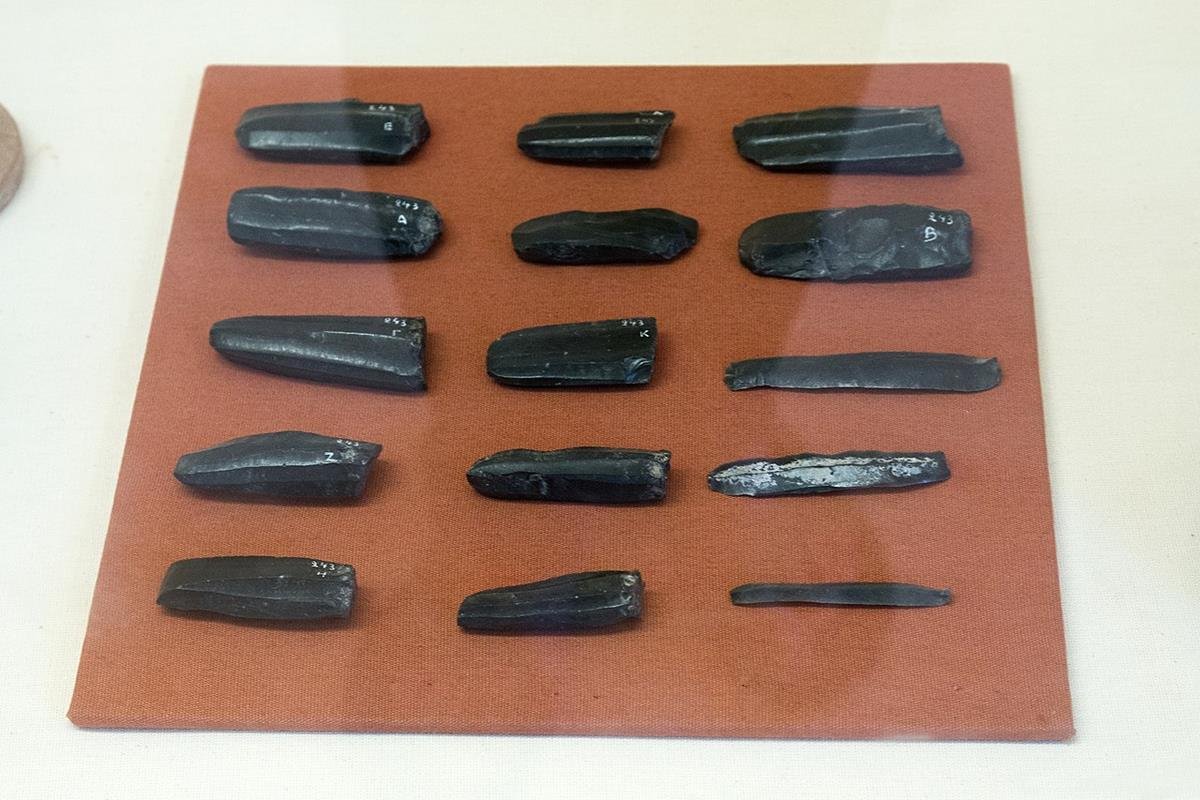Obsidian is mostly a black or dark gray natural volcanic glass formed when rhyolite magma or lava rapidly cools. A natural volcanic glass is an amorphous solid formed when rapid cooling of magma/lava doesn’t give time for crystals to grow.
Some of the characteristics of obsidian are that it is brittle and has a conchoidal fracture. Its Mohs hardness scale is 5–6, its specific gravity is 2.30–2.58 g/cm3, and it has a reflective index of 1.48–153.
Apart from the ordinary black and gray, some varieties have vivid and vibrant colors and sheens caused by inclusions. Some of the colorful varieties, like rainbow, fire, gold, silver sheen, or snowflakes, are much sought after by rockhounds and jewelry.
Today, we will look at the eight modern and historical uses of obsidian.

Modern obsidian uses
Obsidian has many modern uses which include the following:
1. Surgical use in medicine
The edge of obsidian is sharper than that of metallic blades. It can cut less than three nanometers thick, making it an excellent choice for surgical scalpels or knives.
Although it is sharper and will cause less inflammation, it is brittle and thus potentially hazardous. Please note that the FDA hasn’t approved the use of obsidian knives or scalpels.
2. Semi-precious gemstones
Obsidian is highly reflective and has a glassy luster, making it a perfect semiprecious gemstone for making jewelry and ornamental items.
The rare, vibrant, and colorful obsidian types, like gold or silver sheen, fire, rainbow, mahogany, chatoyant, leaf, midnight lace, pumpkin, and seafoam, are usually highly prized gemstones.
Their uses include making bracelets, rings, earrings, necklace pendants, brooches, and pendants. They also make ornamental items like hearts, towers, or spheres. Some are tumbled, cut en cabochon, or used as composites with black opal.
3. Turntable plinths
Another surprising use of cast, powdered obsidian, is in turntable plinths. This volcanic glass is aesthetically appealing, and its high density helps dampen vibration that would otherwise dampen sound quality. It is also heavy and will ensure stability.
For instance, the Technics SH-10B7 and Continuum Audio Lab turntables have obsidian plinths. This natural glass reduces resonance, improves sound quality, and makes them stable.
4. Landscaping and xeriscaping
You can use crushed obsidian for landscaping and xeriscaping. Its vivid color will add charm and elegance to your garden or backyard and create contrast.
Some ideas for using obsidian in landscaping include mulching, in water features, on pathway borders, or around flowerbeds.
5. Some obsidian deposits host valuable minerals
Some obsidian deposits have lithophysae that host valuable minerals like clinoferrosilite and fayalite. Clinoferrosilite occurs in Obsidian Cliff, Park County, Wyoming, and the Coso Mountains, Inyo County, California, USA.
Fayalite also occurs in Obsidian Cliff and other places like Monroe in New York, St. Peter’s Dome in Colorado, Rockport in Massachusetts, and Monroe in New York.
6. Archaeological significance
Archeologists track and date ancient artifacts to reveal information on trade routes and ancient societies. Common dating methods include radiocarbon, considering their stratigraphic location, hydration level, and other techniques.
Ancient obsidian uses
Humankind used obsidian during the Acheulian age, which lasted from 3.4 million years ago to about 2000 BC, in various ways, including:
1. Prehistoric tools
Artifact studies reveal that obsidian, flint, and chert were used to make tools because their conchoidal fractures yielded a sharp edge. Tools made included axes, daggers, scrappers, bladelets, and other chipped tools. Their uses were for hunting, wars, cutting umbilical cords, and circumcision.
The stone tools have been found in various places worldwide, including Kariandusi in Kenya, Lipari in Italy, and other parts of Europe, Asia, the Middle East, and the Americas.
Today, some of these stone tools and artifacts, like Aztec swords and mirrors or Maya knives, still exist. Also, some societies, like Oceania, traded these tools as recently as 1000 years BC.
2. Decorative ornaments
The Greeks, Romans, Aztecs, and other prehistoric civilizations made decorative ornaments using obsidian. These ornamental items included bowls, pendulums, statues, carvings, chalice plates, mugs, and towers.
